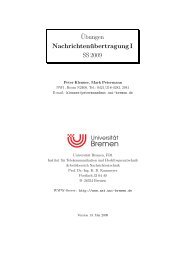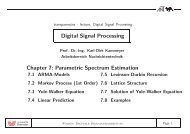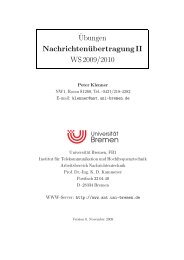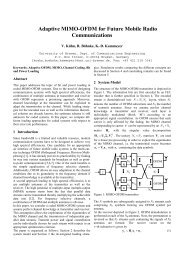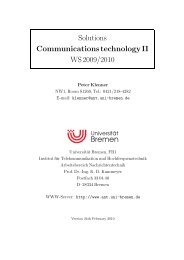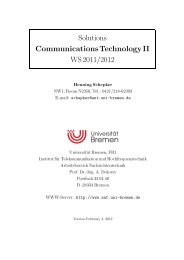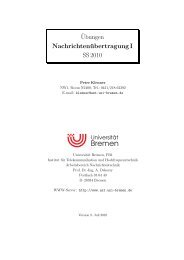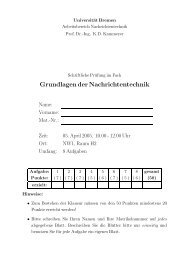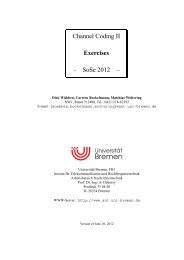Channel Coding I Exercises â WS 2012/2013 â - Universität Bremen
Channel Coding I Exercises â WS 2012/2013 â - Universität Bremen
Channel Coding I Exercises â WS 2012/2013 â - Universität Bremen
You also want an ePaper? Increase the reach of your titles
YUMPU automatically turns print PDFs into web optimized ePapers that Google loves.
3 LINEAR BLOCK CODES November 7, <strong>2012</strong> 5<br />
3 Linear block codes<br />
3.2 Finite field algebra<br />
Exercise 3.1<br />
2-out-of-5-code<br />
a) Given is a simple 2-out-of-5-code of the lengthn=5 that is composed of any possible words with<br />
the weight w H (c) = 2. Specify the code C. Is it a linear code?<br />
b) Determine the distance properties of the code. What is to be considered?<br />
c) Calculate the probability P ue of the occurrence of an undetected error for the considered code at<br />
a binary symmetric channel. The transition probabilities of the BSC shall be in the range 10 −3 ≤<br />
P e ≤ 0.5. Represent P ue in dependence on P e graphically and depict also the error rate of the<br />
BSC in the chart.<br />
d) Check the result of c) by simulating a data transmission scheme in MATLAB and measuring the<br />
not detected errors for certain error probabilities P e of the BSC.<br />
Hint: Choose N code words by random and conduct a BPSK-modulation. Subsequently, the<br />
words are superposed with additive white, Gaussian distributed noise, where its power corresponds<br />
to the desired error probability P e = 0.5 · erfc( √ E s /N 0 ) of the BSC. After a hard-decision of<br />
the single bit, the MLD can be realized at the receiver by a correlation of the received word and<br />
all possible code words with subsequent determination of the maximum. Subsequently, the errors<br />
have to be counted.<br />
e) Calculate the error probability P w at soft-decision-ML-decoding for the AWGN-channel.<br />
f) Check the results of e) with the help of simulations in the range −2 dB ≤ E s /N 0 ≤ 6 dB.<br />
Compare the obtained error rates with the uncoded case.<br />
Hint: You can use the same transmission scheme as in item d). But this time, the hard-decision<br />
has to be conducted after the ML-decoding.<br />
Exercise 3.2<br />
Field<br />
Given are the sets M q := {0,1,...,q −1} and the two connections<br />
• addition modulo q<br />
• multiplication modulo q<br />
Calculate the connection tables for q = 2,3,4,5,6 and specify, from which q results a field.<br />
3.3 Distance properties of block codes<br />
Exercise 3.3<br />
Error correction<br />
Given is a(n,k) q block code with the minimal distance d min = 8.



